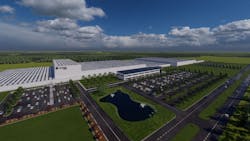Envision AESC building 30-GWh EV Battery Gigafactory in Kentucky
A Japanese electric vehicle battery technology firm will invest $2 billion to build a gigafactory manufacturing plant in Kentucky.
Envision AESC is planning a massive 30-GWh Gigafactory at the Kentucky Transpark industrial development site. The Bowling Green facility is designed to create 2,000 jobs to produce battery cells and modules for new EVs from multiple automotive manufacturers.
The construction plans echo the company’s move to add several EV battery manufacturing plants in the southern U.S.
Once completed the Envision AESC site would raise Kentucky’s overall EV battery manufacturing capacity to 116 GWh, making it tops among U.S. states, according to officials.
“The scale of this project is like nothing our community has ever seen before,” said Bowling Green Mayor Todd Alcott. “This announcement boasts the largest investment amount, jobs creation, and facility size in our history. It’s phenomenal for the future of our region.”
Officials say the economic impact of this project will generate $20 billion over the next decade and will also support approximately 5,249 new jobs in the community beyond those who will be working at the facility. At full employment, this project will generate over $233 million in new spending in the community annually
“This major investment builds on our commitment to the U.S. market, supports growth of the electrification supply chain, and secures high value jobs for future generations in the region,” Envision AESC Group CEO Shoichi Matsumoto said. “This commitment takes us one step further towards our ambition to make high-performance, longer-range batteries for a diverse range of automotive manufacturers worldwide to support the EV transition.”
Related e-Mobility stories
Mercedes-Benz EQ to be served by Envision AESC Battery Gigafactory
BP and Daimler Truck to develop H2-powered Trucks and Hydrogen production infrastructure
Envision AESC globally hopes to produce battery cells and modules to power up to 300,000 new EVs annually by 2027.
Earlier this year, Mercedes-Benz announced that Envision AESC will supply high-performance cell modules for all its EQ electric vehicles assembled at the new EV plant in Alabama. Under the agreement, Envision AESC will support end-to-end production for the EQs at the Tuscaloosa, Ala., facility which Mercedes Benz opened this year.
(Rod Walton, senior editor for EnergyTech, is a 14-year veteran of covering the energy industry both as a newspaper and trade journalist. He can be reached at [email protected]).
About the Author
Rod Walton, EnergyTech Managing Editor
Managing Editor
For EnergyTech editorial inquiries, please contact Managing Editor Rod Walton at [email protected].
Rod Walton has spent 17 years covering the energy industry as a newspaper and trade journalist. He formerly was energy writer and business editor at the Tulsa World. Later, he spent six years covering the electricity power sector for Pennwell and Clarion Events. He joined Endeavor and EnergyTech in November 2021.
Walton earned his Bachelors degree in journalism from the University of Oklahoma. His career stops include the Moore American, Bartlesville Examiner-Enterprise, Wagoner Tribune and Tulsa World.
EnergyTech is focused on the mission critical and large-scale energy users and their sustainability and resiliency goals. These include the commercial and industrial sectors, as well as the military, universities, data centers and microgrids. The C&I sectors together account for close to 30 percent of greenhouse gas emissions in the U.S.
He was named Managing Editor for Microgrid Knowledge and EnergyTech starting July 1, 2023
Many large-scale energy users such as Fortune 500 companies, and mission-critical users such as military bases, universities, healthcare facilities, public safety and data centers, shifting their energy priorities to reach net-zero carbon goals within the coming decades. These include plans for renewable energy power purchase agreements, but also on-site resiliency projects such as microgrids, combined heat and power, rooftop solar, energy storage, digitalization and building efficiency upgrades.

